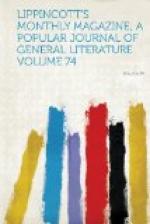from the methods of his literary work. There
was, however, no room for conjecture on this point,
as the fact was early a matter of notoriety, and many
of the illustrations in his books were known to be
from his own sketches. Recently, too, a publication
containing some of his earliest and slightest work
in this way attracted considerable attention, with
the fortunate result of calling out the volume before
us, which embodies the best specimens of his skill
reproduced by a method that renders every line an exact
transcript, and accompanied by facsimiles of whatever
written text or comment appeared on the same page.
Many of them partake more or less of the nature of
caricature, and if the execution alone be considered,
they show that Thackeray might, in default of talents
of a different order, have pursued this line with
as much success as some of its cleverest cultivators.
But what distinguishes the drolleries in this book
is the inventiveness shown in the conception and the
characteristic ingenuity of the details. The designs
for “Playing Cards,” in which the tray
of spades is represented by the figures of Johnson,
Boswell and Gibbon, and a scene at “Dr. Birch’s
School” does duty for the seven of hearts, are
especially felicitous in this way; while a different
but not less familiar trait is exhibited in some carefully-drawn
“Initial Letters,” embodying charming bits
of child-life and quaint allusions to well-known scenes
in history and romance. “Othello”
in the form of “Dandy Jim of Souf Caroline,”
and “The Little Assessor of Tuebingen”—a
mysterious personage of whom the author refused to
reveal the secret—are equally amusing and
suggestive. There are some half hundred subjects
of the same or other kinds in the volume, which, as
a mere picture-book, is full of entertainment for
readers of all ages, while for those with whom the
name of Thackeray is a dear household word it will
have a still higher charm, calling up as it does so
many associations connected with the author and the
man, and seeming like a fragment of the biography which
has been vainly looked for.
BOOKS RECEIVED.
The Illustrated Annual Register of Rural Affairs for
1876. By J.J.
Thomas. Albany: Luther Tucker & Son.
The Chevalier Casse-Cou: The Red Camellia.
By Fortune Du Boisgobey. Translated from the
French by Thos. Picton. New York: Robert
M. De Witt.
Household Elegancies. By Mrs. C.S. Jones
and Henry T. Williams. New
York: Henry T. Williams.
The Children’s Treasury of English Song.
By Francis Turner Palgrave.
New York: Macmillan & Co.
Stories from the Lips of the Teacher. By O.B.
Frothingham. New York:
G.P. Putnam’s Sons.
Songs of Three Centuries. Edited by J.G.
Whittier. Boston: James R.
Osgood & Co.
Roddy’s Reality. By Helen Kendrick Johnson.
New York: G.P. Putnam’s
Sons.



